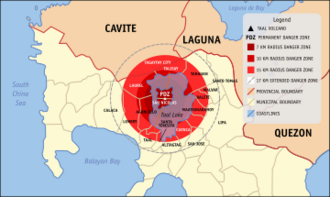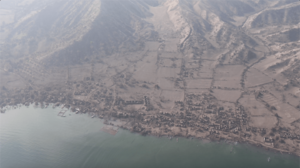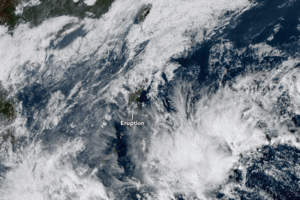2020–2022 Taal Volcano eruptions facts for kids
Quick facts for kids 2020–2022 Taal Volcano eruptions |
|
|---|---|

The January 12, 2020 eruption
|
|
| Volcano | Taal Volcano |
| Date | First eruption January 12–22, 2020 Second eruption Third eruption March 26-31, 2022 |
| Type | Phreatomagmatic, Phreatic, Plinian |
| Location | Batangas, Calabarzon, Philippines 14°00′38″N 120°59′52″E / 14.01056°N 120.99778°E |
| VEI | 4 (January 2020 eruption) |
| Impact | 39 dead (only 1 direct, 38 indirect) |

Map of Batangas highlighting the areas under the 14-kilometer radius danger zone
|
|
Taal Volcano in Batangas, Philippines began to erupt on January 12, 2020, when a phreatomagmatic eruption from its main crater spewed ashes over Calabarzon, Metro Manila, and some parts of Central Luzon and Ilocos Region, resulting in the suspension of school classes, work schedules, and flights in the area, as well as temporarily drying up Taal Main Crater Lake and destroying Vulcan Point, an Island surrounded by the lake. The Philippine Institute of Volcanology and Seismology (PHIVOLCS) subsequently issued an Alert Level 4, indicating "that a hazardous explosive eruption is possible within hours to days." Volcanic activity continued into 2021, when smaller eruptions occurred in July 2021. On 26 March 2022, a short-lived phreatomagmatic eruption was recorded by PHIVOLCS raising the status from Alert level 2 to Alert level 3 as well as surrounding towns.
Contents
Volcanic activity
2020
The volcano erupted on the afternoon of January 12, 2020, 43 years after its previous eruption in 1977. According to PHIVOLCS director Dr. Renato Solidum, seismic swarms began at 11 am and were later followed by a phreatic eruption from Volcano Island Main Crater at around 1 pm Philippine Standard Time (UTC+8). Loud rumbling sounds were also felt and heard from the volcano island. By 2:30 pm, PHIVOLCS raised the alert status to Alert Level 2, although PHIVOLCS through its Taal Volcano Observatory had advised residents of Volcano Island to evacuate at around 1 pm. Stronger explosions began around 3 pm that spewed an ash column exceeding a kilometer high, prompting PHIVOLCS to upgrade the alert status to Alert Level 3 by 4 pm. Furthermore, Solidum confirmed that there was a magmatic intrusion that was driving the volcano's unrest. PHIVOLCS advised evacuation of the towns of Balete, San Nicolas, and Talisay in Batangas and other towns within the shores of Taal Lake. By 7:30 pm, PHIVOLCS upgraded the alert status to Alert Level 4 after volcanic activities intensified as "continuous eruption generated a tall 10 to 15 kilometres (6.2 to 9.3 mi) steam-laden tephra column with frequent volcanic lightning that rained wet ashfall on the general north as far as Quezon City and Caloocan." Ashfall from the volcano were also experienced in Cavite and Laguna, and reached as far as Metro Manila and Pampanga.
On January 13, PHIVOLCS reported that the activity on its main crater had transitioned into a lava fountain between 2:48 am to 4:28 am. A lava fountain was recorded at 3:20 am. The Department of Environment and Natural Resources (DENR) presented a study that the air quality index of cities in Metro Manila had worsened; Mandaluyong had the highest amount of inhalable coarse particulate matter (PM10) with 118, followed by Las Piñas (108) and Taguig (104), all of which were "considered unhealthy for sensitive groups" with respiratory issues. Meanwhile, the cities with the least amount of PM10 were San Juan and Malabon, both with "good" amounts of 22 and 28 respectively. These were followed by "moderate/fair" amounts of PM10 in Pasig (55), Parañaque (62) and Makati (63).
By January 15, PHIVOLCS reported that the slightly acidic lake which filled the main crater prior to the eruption had dried up, which was after confirmed by European satellite observations. On January 28, the main crater emitted 800 meters of steam according to an 8 am bulletin by PHIVOLCS. It was described as a "below instrumental detection", while Alert Level 3 remained raised.
On August 18, PHIVOLCS reported a 20-meter steam emission from the volcano's main crater and several volcanic earthquakes within its vicinity. Subsequent earthquakes have been recorded until late August. PHIVOLCS asserted that the volcanic activity was normal but advised local governments to remain prepared in case of an eruption.
2021
In February 2021, after over a year of the 2020 eruption, the Batangas provincial government ordered residents from Taal Volcano Island to be preemptively evacuated due to the volcano's increasing activity. On March 9, PHIVOLCS raised the volcano's alert level to number 2 and said that it is showing signs of an "increased unrest".
In late June, localities near the volcano experienced volcanic smog or vog caused by the volcano's emission of sulfur dioxide, amounting to 14,326 tonnes on June 28. The vog was confirmed to have reached as far as the Central Luzon region.
On July 1, the volcano erupted at around 3:16 p.m. local time and lasted for five minutes, and the alert level was raised from level 2 to level 3. The volcano had several smaller eruptions later that day. On July 4, PHIVOLCS reported Taal Volcano's highest sulfur dioxide emission on record. By July 7, the volcano had a short-lived phreatomagmatic eruption occurred in the Main Crater at 5:18 a.m. local time and generated a grayish plume that rose 300 meters high before drifting southeast. This was followed by a phreatomagmatic burst and weak eruption at 8:47 a.m. for seven minutes, which generated another 300-meter-high plume. Two more phreatomagmatic events were recorded by PHIVOLCS at 9:15 a.m. and 9:26 a.m., lasting for two minutes and five minutes. Another phreatomagmatic burst occurred at 11:56 a.m., which generated a 200-meter-high dark gray plume. Six short-lived phreatomagmatic eruptions were recorded in Taal on Wednesday alone, the latest being at 9:41 p.m., the report added, citing Paolo Reniva of the Taal Volcano Observatory. Also on July 8, another short-lived phreatomagmatic eruption occurred in the Main Crater at 6:47 am local time and generated a 200-meter grayish plume. This was followed by three more phreatomagmatic bursts at 6:06 p.m., 9:21 p.m. and 9:50 p.m. On July 9, another phreatomagmatic burst occurred at 2:59 a.m. On July 23, PHIVOLCS lowered the alert level status from Alert Level 3 to Level 2.
After several months of continued unrest, series of 2 short-lived phreatomagmatic eruptions were recorded on several thermal webcams nearby at 1:46 a.m. and at 2:54 a.m. on November 17, 2021. There is also a chance there was another short-lived eruption a few days prior to the eruptions on the 17th.
2022
Between January 29 and 30, 2022, the volcano had nine phreatomagmatic bursts on its main crater.
On March 26, PHIVOLCS raised the volcano's alert level status to Alert Level 3 due to a short lived-phreatomagmatic eruption with the evacuation of around 1,100 residents around the area and surrounding towns. Two phreatomagmatic events were recorded in which it emitted toxic plumes of 800 meters and 400 meters. Locals have then reported an explosion near the crater around 1:00 pm (Philippine Time) with subsequent spurs of ashes around the lake. High level toxic emissions have been recorded as well as 14 volcanic earthquakes and 10 volcanic tremors within the day. The next day on March 27, volcanic activities were relatively tranquil with almost no recorded earthquakes although sulfur dioxide emission still measured at 1,140 tonnes.
On April 9, PHIVOLCS downgraded again the alert level status from Level 3 to Level 2.
Seismic activity
On February 13, 2020 the National Disaster Risk Reduction and Management Council (NDRRMC) and the Philippine Institute of Volcanology and Seismology (PHIVOLCS) have reported a total of 2,484 volcano tectonic earthquakes on the vicinity of the volcano since the eruption, 176 of which were felt. The strongest were a series of Mw 4.1 magnitude earthquakes originating 6 kilometers (3.7 mi) northwest of Agoncillo, Batangas, which were recorded at least thrice: at 11:56 pm on January 12, 3:11 am on January 13, and 6:35 am later that day. As a result, an Intensity III ("weak") on the PHIVOLCS Earthquake Intensity Scale was felt in Tagaytay and an Intensity II ("slightly felt") was felt in Malabon. Between 11:39 pm on January 13, 2020, and 5:50 am the following day, PHIVOLCS reported a total of 44 earthquakes in the towns of Calaca, Laurel, Lemery, Mataasnakahoy, San Luis, Taal and Talisay in Batangas, and Alfonso in Cavite; among the strongest were a magnitude Mw 3.6 in Taal, which was felt at an Intensity III in Tagaytay, and a magnitude Mw 3.9 originating 7 kilometres (4.3 mi) northeast of Talisay at 2:05 am, measuring an Intensity IV ("moderately strong") in Tagaytay and Intensity II in Malabon and Pasay.
As a result of these constant earthquakes, numerous fissures or cracks appeared across different barangays in the Batangas towns of Agoncillo, Lemery, San Nicolas, and Talisay, the towns within the 14-kilometer radius danger zone of Taal. A fissure also transected the road connecting Agoncillo to Laurel. On January 15, PHIVOLCS reported that the water in Main Crater Lake on Volcano Island had drained; the lake measured 1.9 kilometers wide and 4 metres (13 ft) above sea level. Portions of the Pansipit River, had also drained as a result of "the ground deformation caused by an upward movement of the magma"; it was the same process that caused the series of earthquakes. PHIVOLCS have also hinted at the possible existence of underwater fissures in Taal Lake into which the water may have drained.
By January 27, from 5 am until January 28, only 3 volcanic earthquakes were recorded with magnitudes 1.5 to 2.2, with no felt event. As recorded by the United States Geological Survey, 92 earthquakes were detected in the past 24 hours. Four of them are low frequency events, which are "caused by cracks resonating as magma and gases move toward the surface". PHIVOLCS also noted the low frequency events and they recorded 170 volcanic earthquakes in its 8 am bulletin.
Impact
Casualties
A total of 39 people died as a result of this eruption of Taal, although only one reported case was directly caused by the eruption on January 12, 2020. According to the Manila Bulletin, people either perished because they refused to follow the evacuation order or decided to return to their homes, or died in the evacuation centers of heart attacks caused by anxiety. One person died in a collision along the South Luzon Expressway in Calamba, Laguna during "zero visibility" conditions caused by ashfall. On February 15, 2020, a body of a man was recovered under mud and ash at Taal Volcano Island.
Economic
Demand for N95 masks increased rapidly during the eruption and later, the COVID-19 pandemic (after the Philippines' first case was reported on January 30), with some stores inflating its prices to ₱200 ($3.95) a piece from the standard ₱25–40 ($0.49–0.79). The Department of Trade and Industry (DTI) dispatched teams to monitor and observe the movement of retail prices in the market and warned businesses against raising prices for higher profit margins. After DTI inspection, Trade Undersecretary Ruth Castelo commented that some medical establishments were selling 'fake' N95 masks, some of which are not medical-grade, and could still let in large foreign air particulates. Due to the outcome of surprise inspections and consumer complaints, DTI has imposed notices of violation to 12 of the 17 stores that were inspected in Bambang, Manila, citing that these businesses will be charged with administrative and criminal cases for violating the Consumer Act. Manila Mayor Isko Moreno threatened to revoke the permits of medical supply chains in the city involved in the price hike of face masks. Mercury Drug, a major pharmaceutical chain, pledged to replenish supply for the masks where prices would remain steady and that it would not hoard the supply. The Department of Health imposed price controls on health-related goods, including face masks, to protect consumers from profiteering and hoarding. The DOH mandates that the prices of N95 masks, in particular, should range between ₱45–105 ($0.89–2.07).
The Philippine Stock Exchange suspended trading following the eruption on January 13.
The Department of Agriculture (DA) reported that the damage to crops caused by the eruption are estimated to be ₱3.06 billion ($60.1 million), covering 2,722 hectares (27.22 km2) that includes 1,967 animals. Fisheries in the Taal Lake, consisting of about 6,000 fish cages to capture a total of 15,033 metric tons of fish, suffered losses of ₱1.6 billion ($31.4 million). Kapeng barako and Coffea liberica crops, major products of Batangas and Cavite, have damages worth at least ₱360.5 million ($7.08 million) for 8,240 metric tons and 748 hectares (1,850 acres) of land. Pineapple plantations in the Cavite towns of Amadeo, Silang and General Trias lost 21,079 metric tons of pineapple worth ₱527.25 million ($10.4 million). Rice crops in 308 hectares (760 acres) of fields across Calabarzon were lost, amounting to ₱5.6 million ($109,985), while 5,329 metric tons of corn placed losses at ₱88.9 million ($1.7 million). The Philippine Crop Insurance Corporation reassured around 1,200 farmers and fishermen in Batangas that they are insured of a three-year zero-interest survival and recovery loan worth ₱25,000 ($494.13) each, to be provided by the Mount Carmel Rural Bank. The DA plans to distribute materials and mechanisms for crop and livestock intervention worth ₱160 million ($3.1 million), which includes 5,000 coffea mother plants and 1,000 cocoa bean seedlings from the Bureau of Plant Industry, to 17 local government units in Batangas. The Philippine Carabao Center and National Dairy Authority delivered 1 tonne (15,000,000 gr) of corn silages and 1.5 tonnes (23,000,000 gr) of rice straws, a total of 2.5 tonnes (39,000,000 gr) of dietary fiber, to Batangas.
A brickworks in Biñan, Laguna used the ash spewed from Taal to manufacture hollow blocks and bricks. Through a combination of ash, sand, cement and discarded plastic waste, around 5,000 bricks were manufactured a day and used to rebuild houses and other buildings that were damaged by the eruption. Biñan Mayor Arman Dimaguila formally instructed residents in the city to help gather ashes and deliver it to the local brickworks.
The Smart and Globe telephone companies offered free calls, internet services and charging stations for those affected. Water concessionaire Manila Water, in cooperation with Batangas Provincial Disaster Risk Reduction and Management Office, sent a convoy of 30 water tankers to various evacuation centers in Batangas. The company is also sending an initial 2,000 five-gallon units of bottled water. Meralco, the country's leading power distributor, assembled solar-powered mobile charging stations at various evacuation centers across Cavite.
PhilPost announced on January 16 that it would suspend delivery and acceptance of mail in Batangas towns near the Taal Volcano which falls within the "danger zone".
Health
The Department of Health advised the public to remain indoors and minimize outdoor activities. They also advised the public to refrain from purchasing and consuming freshwater fish from the Taal Lake, such as tilapia and Sardinella tawilis, as these may have been affected by the sulfur from the eruption.
Agriculture Secretary William Dar clarified that fruits and vegetables filled with ash, including the Coffea liberica fruits that are homegrown in Batangas and Cavite, are safely consumable upon cleansing.
Air traffic
On January 12, 2020, the Manila International Airport Authority (MIAA) suspended all flights to and from all terminals of Ninoy Aquino International Airport (NAIA) in Manila following the eruption due to the various hazardous effects of volcanic ash on flight safety. The MIAA recorded that at least 516 flights from and to NAIA were suspended, with about 80,000 passengers affected. On January 13, operations at NAIA resumed partially from 10 am onwards, although many flights still remained canceled or delayed. A number of international flights bound for NAIA were diverted to either Clark International Airport in Angeles City, Mactan–Cebu International Airport, Haneda Airport in Tokyo, Hong Kong International Airport, or Antonio B. Won Pat International Airport in Guam. By January 14, 604 flights were canceled according to the NDRRMC. However, by January 15, 537 of those flights had resumed operations.
The Civil Aviation Authority of the Philippines advised the Luzon International Premiere Airport Development Corporation to suspend flights at Clark International Airport as reports indicate that ash could reach the area. On January 13, only ten flights were reported to have been canceled, while nine flights were delayed.
At Mactan–Cebu International Airport (MCIA), only 25 domestic flights (all bound for NAIA) and one international flight were canceled, all of which were on January 14. However, the MCIA had to accommodate five international flights bound for NAIA that were diverted. The GMR–Megawide Cebu Airport Corporation (GMCAC), the operator of the MCIA, requested that all diverted flights should be accommodated on a "first-come, first-serve basis" depending on the availability of aircraft parking bays. Aside from hotel bookings, passengers of the diverted flights were given small food packs. MCIA provided passengers with free bus services for inter-airport transfers and city hotel transfers. Retail stores and food concessionaires at the airport terminals immediately restocked their supply and offered discounts for passengers, available from January 12 to 14.
Sports
Collegiate leagues, the University Athletic Association of the Philippines (UAAP) and the National Collegiate Athletic Association (NCAA) postponed games to be held in Metro Manila on January 13, 2020, due to ash fall. The junior basketball and junior football ties were to be held by the UAAP and volleyball games for the NCAA. The AFC Champions League match between Ceres–Negros and Shan United scheduled for January 14, 2020, at the Rizal Memorial Stadium in Manila was threatened to be postponed due to ash fall the day before but match officials decided that game should push through.
See also
- List of large volcanic eruptions in the 21st century








